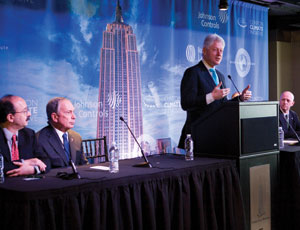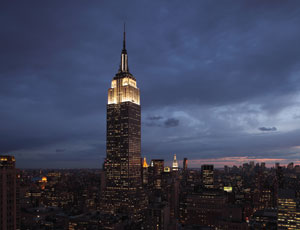When the owners of the Empire State Building in 2007 decided to move forward with a new capital improvement plan, they were looking for standard improvements to get the building to Class A commercial status. At the time they were looking at traditional, "common sense" improvements, such as bringing the 25% to 30% of the building lacking air conditioning some thermal control.


Meanwhile, the Clinton Climate Initiative, which had just launched its operations in New York, was looking for an iconic project to announce its retrofit division to the rest of the world.
“One of our staff members was a family friend of the Malkins, owners of the Empire State Building,” says Kathy Baczko, city director of New York’s chapter of CCI. The Malcolm family owned 16 pre-war buildings and offered one of them to CCI as its kickoff project. “But [Jamie Russell, the CCI senior director] said, ‘Let’s do something more than a building on Broadway. Let’s do the Empire State building.’ It was serendipity.”
CCI, in conjunction with Johnson Controls, Jones Lang LaSalle, and the Rocky Mountain Institute, did an eight-month modeling and projections analysis, tacked on $13.2 million for a greening initiative and came up with a way to reduce the 79-year-old building’s electricity needs by almost 40 percent – saving the owners $4.4 million, annually. Then they released the model of the entire process, “a total record of everything,” as Baczko describes it, to anyone who wants to follow it, right on www.esbsustainability.com.
The Economic ModelThe marriage of greening the environment on the one hand and financial incentives to would-be polluters on the other goes back decades. In its most insincere form, it’s greenwashing: touting environmental credentials, like bicycle racks, floor-to-ceiling windows, and sustainably-harvested floors – that nonetheless require CO2-emitting airplanes for transport – to attract tenants at premium prices; or boasting of LEED certification that came at the cost of not much more than doing the paperwork. At its purest form, using economics to push for greener alternatives has allowed the do-gooders to communicate in a language that capital understands.
In practice, the revolutionary green projects in New York, such as the New York Times tower and the Bank of America building at One Bryant Park, went beyond the call of duty or LEED points to analyze every possible option in reducing energy costs. The Times building team spent a year analyzing sun movement to perfect the combination of heat-deflecting ceramic rods and window types for optimal heating and cooling. Similarly, the Bank of America team tested wind turbines for a year to see if they would generate enough electricity and experimented with photovoltaics, before settling on even more effective methods of cutting down on energy use. Both are iconic projects, having pushed the envelope at significant research and development costs that others still try to replicate.
The key difference between these earlier projects and what’s happening at the Empire State Building is precisely that – cost. Experts interviewed for this magazine as late as 2008 have cited discrepancies in LEED points, fluctuating materials costs, and other factors for the lack of consensus among them on how much exactly it actually costs to build green. To that end, the Empire State Building team started with the numbers.
“The skeleton of this was that we first looked at the plans for the building – capital plans, occupancy plans, marketing plans, to firmly see the business,” says Paul Rode, executive project manager for Johnson Controls. “Second, we needed to understand the building at a mechanical and architectural level – touching, drawing, researching what’s there. The next phase was inspired by RMI – now that we know what the building is, what can we do to it to make it more efficient?”
The NumbersThe Empire State Building’s retrofit press releases do not sugarcoat what the team set out to achieve. The releases tout a, “commercially-attractive retrofit,” and “a significant return on investment, both environmentally and financially.” The overall upgrade program will cost $500 million by the time it’s completed in 2013. The $4.4 million in annual energy savings will be the result of an incremental cost of $13.2 million on top of that. The payback on that increment occurs in 3.1 years. The other payback is the expected LEED Gold for Existing Buildings.


Post a comment to this article
Report Abusive Comment